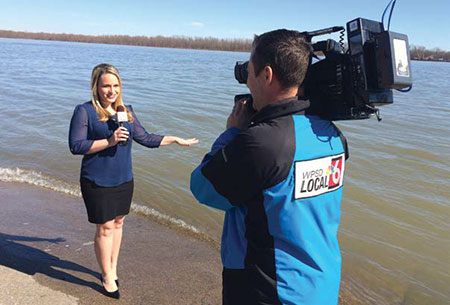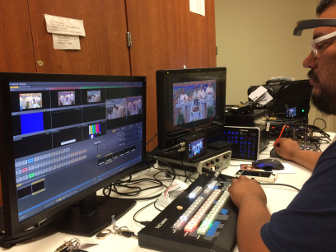ENG Widens Its Scope
OTTAWA—One good idea begets another: cellular bonding— sending compressed H.264 video from the field over multiple cellular telecom channels, to provide master control with a reliable live feed—has provided TV broadcasters with a highly portable, low-cost alternative to microwave and satellite transmission for a decade. It’s proven to be such a good idea that broadcasters and transmitter manufacturers alike have not only embraced “cellular ENG,” but taken it to the next level.

NBC affiliate WPSD in Paducah, Ky. recently expanded its field newsgathering capabilities with the Aviwest DMNG PRO 180 3G/4G bonded cellular video transmission system distributed by Vidovation in the U.S.
Today, this includes converting the outgoing feeds into IP video (making it seamlessly transportable across Wi-Fi and Ethernet networks), and also sending out these signals via licensed radio bands, allowing broadcasters to create their own private cellular ENG networks. For broadcasters of all sizes, this means that cellular ENG equipment is doing much more than just providing cost-effective, highly portable live TV feeds from anywhere; including places that microwave/SNG trucks just can’t go.
GETTING TO AIR, ANYTIME, ANYWHERE
Texas’ Catholic Television of San Antonio broadcasts live religious programming on the local Time Warner Cable network. Among its most popular programs is the annual Good Friday “Passion Play,” showing the crucifixion and resurrection of Jesus Christ that attracts thousands of San Antonians each year. The production begins at Milam Park and heads up the street to conclude outside San Fernando cathedral.
“In the past, whenever we needed to go live, we would work with our local Time Warner office to coordinate the feed between our field crew and master control, before feeding the switched production to the cable channel,” said Dagoberto Patlan, CTSA’s operations manager. “But after Charter Communications bought Time Warner last year, the local TW office was closed down, leaving us to fend for ourselves. This is when we decided to go with cellular ENG, by renting a TVU Networks’ TVUPack cellular 4G/LTE portable backpack transmitter for a live remote event.”
CTSA’s initial experience with the TVUPack transmitter was so positive the channel subsequently bought its own TVUPack to send back switched-multicamera feeds from the field to CTSA’s master control.
INTERCONNECTING QMI
Quincy Media, Inc. swears by its roster of LiveU LU500 cellular ENG portables. “The LiveU portables allow you to send out live feeds from places that microwave/ENG trucks can’t go, like a multistory office building or other remote location,” said Brady Dreasler, corporate director of engineering for QMI. “This is why we have about 30 LiveU cellular ENG transmitters to serve our 14-station broadcast group.”
Get the TV Tech Newsletter
The professional video industry's #1 source for news, trends and product and tech information. Sign up below.

Thanks to the TVUPack portable transmitter, Catholic Television of San Antonio can now shoot/stream remote church services quickly and easily; without outside support.
In addition to using LiveU units for newsgathering, QMI deploys them to cover sporting events such as football, basketball, and hockey. “Some of this coverage we use locally; some for statewide transmission,” said Dreasler. “We can send individual live hits, or fully-produced, switched multicamera feeds back to our group member stations. It is a lot faster, simpler, and cheaper than using a microwave or satellite truck, and it is sure safer than having to raise a 52-foot microwave mast.”
LiveU now integrates their cellular ENG transmitters directly into ENG cameras, “so if you buy a new Panasonic camcorder, for instance, you can get one that streams video directly to the LiveU cloud, where authorized stations can pull the feed offline,” said Avi Cohen, COO. “As well, we have integrated with NewTek’s open Network Device Interface which allows our field units to communicate back to the studio so the video director can mix and then transmit a switched video feed directly from his board to the station and/or LiveU cloud. LiveU can also be integrated directly with Facebook Live, so that feeds sent from a LiveU cellular ENG transmitter can go directly to Facebook for real-time online streaming by unlimited viewers.”
MORE TRANSMISSION OPTIONS
Accelerated Media Technologies, in Auburn, Mass. recently introduced its ENGenesis two-way video transport system that uses broadcasters’ licensed 2/7GHz Broadcast Auxiliary Service (BAS) radio channels instead of commercial cellular networks. “By using your station’s BAS bands, you get to create your own private radio network to move video signals from the field,” said Steve DeFala, AMT’s director of sales. “This protects your signals from being lost when the commercial networks are overloaded—and you don’t have to pay for the airtime.”
Comrex’s LiveShot sends out HD IP video by whatever networks are best available to carry it; be they 3G/4G cellular, Wi-Fi, Ethernet, or a mix of all three. “We can also work with Inmarsat BGAN and VSAT satellite connections,” said Chris Crump, senior director of sales and marketing for the Devens, Mass.-based provider of broadcast technology. “LiveShot even provides low-delay return video with two IFB return channels and a director/camera PL channel, to coordinate live production in the field.”
Dejero’s new LIVE+ EnGo is a camcorder-mounted unit that houses a compact mobile transmitter to encode H.264 video. It transmits this IP video from the camcorder over multiple IP networks to reliably deliver HD video with extremely low latency. “At NAB 2016, we showed the addition of closed-captioning to the LIVE+ EnGo platform, which can be transmitted over cellular, Wi-Fi, Ethernet, and satellite,” said Bogdan Frusina, founder and CTO of Dejero in Waterloo, Ont.
Teradek offers a range of cellular ENG products that can send H.264 IP HD video over 3G/4G/LTE cellular, Wi-Fi, Ethernet, and BGAN satellite. The company recently introduced the Teralink iOS app, which “provides the ability to wirelessly ‘stitch’ four iPhones together; a term our customers cheekily called ‘friends with bandwidth,’” said Jon Landman, Teradek’s vice president of sales. This capability allows Teradek’s Cube cellular ENG transmitter to be used worldwide without requiring onboard modems that are locally compatible, “making our new Cube the lightest cellular bonding device on the market at 8 ounces,” Landman said. “And, with our ‘Core’ cloud management system, we enable control, routing and recording of all feeds via a simple cloud-based GUI.”
Vidovation has partnered with France’s Aviwest to distribute the Aviwest bonded IP and bonded cellular platform in the United States. Aviwest is the most popular ENG supplier in Europe, according to Jim Jachetta, executive vice president of engineering and CTO for Vidovation. “Their equipment is the best in the market, and it conforms to European RF safety standards, which are tougher than ours.” Aviwest’s cellular ENG transmitter comes with dual hardware encoders for two independent transmission paths (one variable for bonded cellular transmission, and one fixed-rate); on-camera video recording for store and forward; and the ability to receive, decode and play out live streams from multiple field units.
James Careless is an award-winning journalist who has written for TV Technology since the 1990s. He has covered HDTV from the days of the six competing HDTV formats that led to the 1993 Grand Alliance, and onwards through ATSC 3.0 and OTT. He also writes for Radio World, along with other publications in aerospace, defense, public safety, streaming media, plus the amusement park industry for something different.

